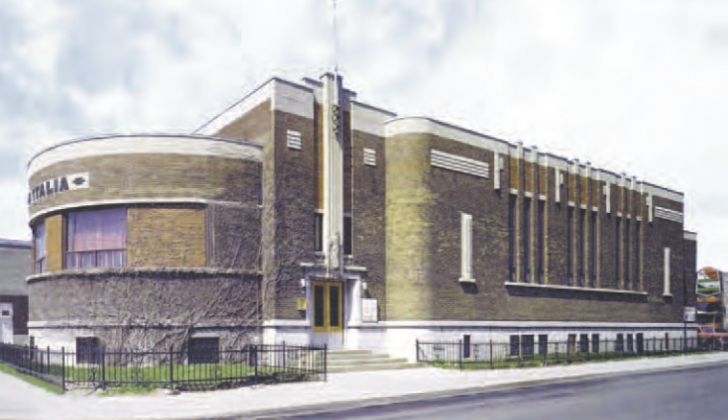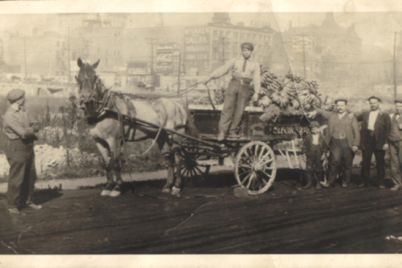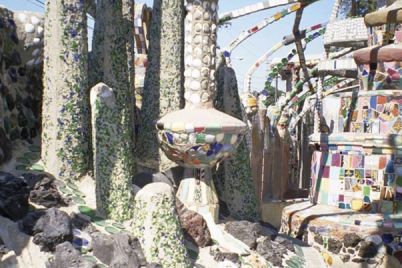In the mid 1960s the Italian community almost lost the Casa d’Italia landmark. It took great effort and much lobbying to prevent the expropriation and demolition of the Casa, whose lot had been earmarked for the construction of a station for Montreal’s newly created Metro system. This event is reflective of the often tumultuous seventy-five year history of the Casa d’Italia – a witness and enduring symbol of the vitality and determination of Montreal’s Italian community.
Foundations
From their original settlement in downtown Montreal, the “colony” of Italians (as it was known then) slowly but surely made its way northward to the Mile End district in pursuit of the Canadian dream. Achieving that dream wouldn’t come easy. Often exploited in the workplace, Italian workers sought support with the Order Sons of Italy (Ordine Figli d’Italia), OFI – an organization with chapters in large cities across the United States and Canada.
On March 9, 1919, Montreal native Sam D’Onofrio and 33 of his compatriots met in a room at the Monument National and founded the city’s first OFI lodge under the name “Loggia Piave.” Fostering a sense of community and unity, the lodge proved popular and membership grew quickly.
Throughout the 1920s, the demand for unskilled labour increased and with it the colony. Although the Italian presence on the North American continent was already impressive, it was about to become far more imposing. With the opening of Pier 21 in Halifax in 1928, larger ocean-going vessels could carry greater numbers of trans-Atlantic passengers, resulting in a tidal wave of Italian immigration. By the 1930s, faced with such an influx, community leaders sought to raise money to erect a building where Italians could congregate and feel at home. Consul General Cav. Giuseppe Brigidi, along with A.Sebastiani, C. Catelli, S.Biffi, M. Paparelli and E. Pasquale pitched their plan and urged members of the Italian colony to support it financially.
In 1933 members of the Italian community had an added incentive to push ahead, when all of Quebec celebrated the landing in Montreal of Italian pilot Italo Balbo and his squadron of hydro planes after a trans-Atlantic flight. The year proved eventful both on the artistic and political front. Guido Nincheri’s controversial fresco depicting Pope Pius XI, Mussolini on horseback, Italo Balbo and Guglielmo Marconi was unveiled at Madonna della Difesa Church.
One year later, the community quietly continued its march towards realizing the Casa d’Italia project, as 6000 Italians voted to re-elect Camillien Houde as mayor of Montreal. He returned the favour by gifting to the OFI a parcel of land located at the corner of Berri and Jean Talon streets. In a gesture of solidarity, the OFI offered the land to the Casa unity initiative. By December 31, 1934, over 4000 individuals had contributed money ranging from ten cents to one hundred dollars to the Casa d’Italia United Fund. Artists Guido Nincheri and Guido Casini offered their talent, companies donated building materials and many private individuals pledged their labour.
The project to design and build the Casa d’Italia was awarded to a 25-year-old Brooklyn-born architect named Patsy (Pasquale) Colangelo (1907-1984). It was Colangelo who decided on Casa d’Italia’s Art Deco design. The Art Deco style was gaining favour in the city during this period, especially through the work of Quebecois architects such as Ernest Cormier, who had designed iconic buildings like the University of Montreal and the Atwater Market.
A cultural institution
On All Saints’ Day, Sunday, November 1, 1936, Casa d’Italia opened its doors. It was a festive occasion as well as an historic rendez-vous between Italians and their French-Canadian friends. Casa d’Italia, the handsome 20th-century Art Deco building erected for the people, was now the heart and soul of Italian community life. From Christmas and Valentine’s Day celebrations to weddings, association meetings, commercial expositions, balls, and theatre, Casa d’Italia was at the centre of it all.
But goodwill and the extraordinary advancement of Italian cultural affairs in Canada came to a screeching halt on June 10, 1940, when Benito Mussolini declared war on Great Britain, Canada and the Allied Powers. Just four years after its festive opening, Casa d’Italia was now seen by the Canadian government as a gathering place for “enemy aliens.” By authority of the War Measures Act, the state seized all Casa documents and ordered the building closed and sequestered. Using the Casa’s membership list, the government arrested and interned in military camps across the country many community leaders and perceived political activists and sympathizers of Fascist Italy.
For those not interned, the government imposed draconian curfews, severely restricting their freedom of movement. Members of the community became victims of widespread prejudice, as many lost their jobs or had their shops vandalized. This shameful episode led many Italians to take the extreme measure of denouncing their heritage, even going as far as changing their names to sever any connection to their Italian roots. Occupied by the Canadian army between 1940 and 1946, Casa d’Italia suffered great physical damage. But a time for rebuilding was near.
Post-war healing and reopening
After the war, as part of the healing process, the Italian community requested the return of Casa d’Italia to its rightful owners. On November 25, 1946, Mayor Camillien Houde was instrumental in fulfilling the request by presenting Private Bill No. 174 in Quebec’s Legislative Assembly. The bill became law on January 1, 1947, and Casa d’Italia was returned to the community. It reopened its doors just in time for the largest wave yet of Italian immigrants to Montreal. Following the election of Marino Paparelli as president of the Casa, leaders sprung into action and activities quickly resumed with plans to expand the 10-year-old Casa to meet the growing needs of the community.
In 1947 the “enemy alien” designation was officially removed and the following year a Canadian embassy opened in Rome, thus facilitating the resumption of Italian immigration to Canada. Canada became an attractive and popular destination thanks to sponsorship programs enacted by the Canadian government. Immigrants could be admitted as long as residing relatives assumed all financial responsibilities for the newcomers during the period of settlement. Large numbers of immigrants settling in the Villeray village, the Jean-Talon Market area and the Papineau-Jean Talon axis created new challenges and the need for more support services.
The Casa maintained an important role within the community, establishing an employment bureau as well as hosting social activities that included weddings and professional and cultural associations. The basement Rotunda housed the Centro Assistenza Agli Immigranti, an association that helped new Italians integrate and find work.
The post-war period witnessed great movement and accomplishments for both Casa d’Italia and Italian Canadians, each leaving a mark on the cultural and political landscape. An important event was the hosting of the American chapter of the Order Sons of Italy. With six million members in the United States, the Order’s importance on Italian cultural affairs cannot be overstated.
Twenty years of growth
By the 1970s, with increasing debt and urgent repairs required, leaders feared the Casa was becoming less and less viable. This changed when Sam Capozzi was elected president in 1979. He provided the renewed leadership, solutions and the financial assistance needed and, in the process, he saved the Casa from closing its doors. Capozzi’s ultimate dream, once the situation stabilized, was to expand Casa d’Italia. Tragically, he passed away before fulfilling his grand vision.
The next 20 years were marked by growth, as new and important organizations anchored themselves within Casa d’Italia. Noteworthy among them are the National Congress of Italian-Canadians (Quebec Region), the Italian-Canadian Community Foundation, the Italo-Canadian Seniors’ Council (CRAIC), the Servizi Comunitari Italo-Canadesi, the Italian Cultural Centre and other cultural and non-profit organizations.
Many attempts were made to redefine, restore and expand Casa d’Italia’s mandate. The issue became all the more urgent with the opening in 2002 of the Leonardo da Vinci Centre in Saint-Leonard, led by Giuseppe Borsellino and the governors of the Canadian Italian Foundation of Quebec. The main community players in Casa d’Italia eventually chose to relocate into the newly built Centre.
After securing the financial participation of all three levels of governments, focus groups were conducted between 2004 and 2006. The objective was to determine the future direction of Casa d’Italia. Renovating the structure no longer sufficed. Casa d’Italia had to profoundly rethink and justify its role in the community. The time had come to think outside the box.
In the meantime, the Boards of both the Casa d’Italia and the Canadian Italian Foundation of Quebec launched a joint fundraising campaign to help raise the balance of the funds required for the expansion and renovation project of Casa d’Italia. The campaign was spearheaded by Nicola Di Tempora, Jean-Pierre Desrosiers and Giuseppe Danisi.
The vocations committee, through much debate, had to clearly and precisely articulate a comprehensive list of components that would point towards a new architectural building program. These were narrowed down to eight. La Galleria would allott a privileged space to commemorate and showcase past and present works, including paintings, photography, sculptures, and travelling exhibits. The Ecomuseum/Discovery Centre would be the welcoming area for school children reliving and sharing the immigration experience through the eyes of their parents and grandparents. It would also be a place where dialogue based on the principle of cultural celebration and tolerance could take place.
The Hall of Celebration would be a gathering place for community groups to carry out socio-cultural activities and public events with cocktail parties, press conferences and dinners. The Italian Canadian Hall of Fame would be a compelling presentation of stories conceived to engage visitors through the valued contributions of Italian Canadians. The Memorial to a People would be situated outside the building, providing visitors an opportunity to witness a visual memorial commemorating past and present Italian Canadians. The Archives/ Library would house a collection of documentary materials (passports, periodicals, photos, books, publications and artefacts) chronicling the heritage of Italian Canadians. The Wall of Remembrance would celebrate our parents, grandparents and pillars and pioneers of the community through a wall-mosaic – a tapestry of names of the thousands of immigrants in search of a new life. The Culinary Laboratory would disseminate Italy’s internationally renowned and prestigious culinary history. Casa d’Italia plans to offer cooking courses with thematic and regional flavours, and explore Italian wines through a complementary winetasting experience.
Recapturing our common patrimony
Casa d’Italia has had 15 presidents. Its three longest serving are Sam Capozzi (1979 to 1992), Joe Fratino (1992 to 1997) and Gaby Mancini (1997 to present). Casa d’Italia’s legacy prevails thanks to their tenacity and vision and that of their Boards. Many celebrities have walked up the Casa’s terrazzo stairs: Guido Nincheri, Cardinal Paul-Émile Léger, Camillien Houde, Maurice Duplessis, Gina Lollobrigida, Pierre Elliott Trudeau, Maurice Richard, Jean Béliveau, Jean Drapeau, Mario Duliani, René Lévesque, Sergio Leone, and Amintori Fanfani, among others. Over time, the terrazzo floor was worn down by thousands seeking employment and social assistance or participating in cultural celebrations.
Casa d’Italia represents our collective memory. It is a part of who we are: our shared values and experiences defining our history. Preserving this memory and heritage is of paramount importance.
With a renewed role, Casa d’Italia will live in our hearts and minds. The permanent preservation of our patrimony pays homage to our past and represents a foundation to face the future with optimism. It serves to bring together not only Italians but everyone in a spirit of cultural tolerance and cooperation.
This is our dream for Casa d’Italia. We invite you to bring along your dreams. Your support and generosity will contribute to its remarkable renaissance.
Pasquale L. Iacobacci is the project manager for the Centre communautaire de la Petite Italie -Casa d’Italia. He can be reached at (514) 271-2524 or pliacobacci@casaditaliamtl.com.
First published in Accenti Magazine, Issue 19.



